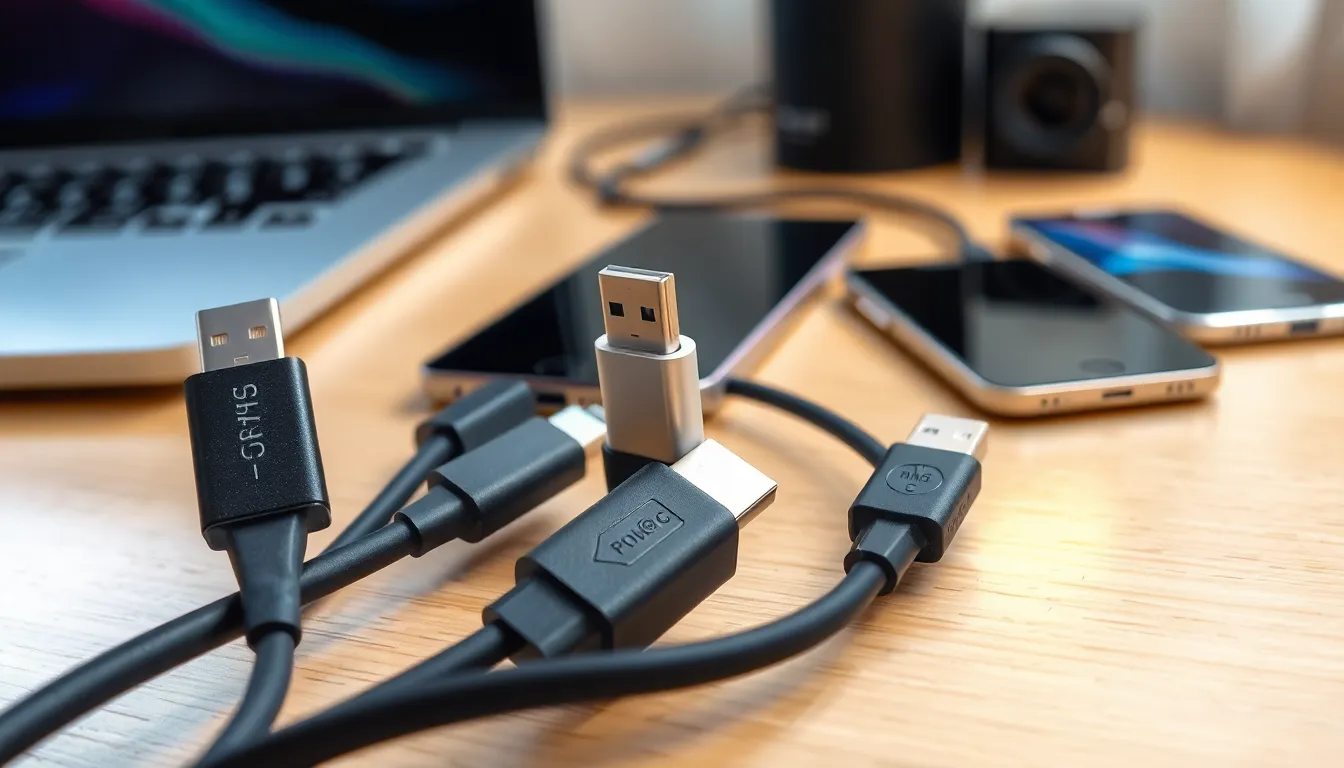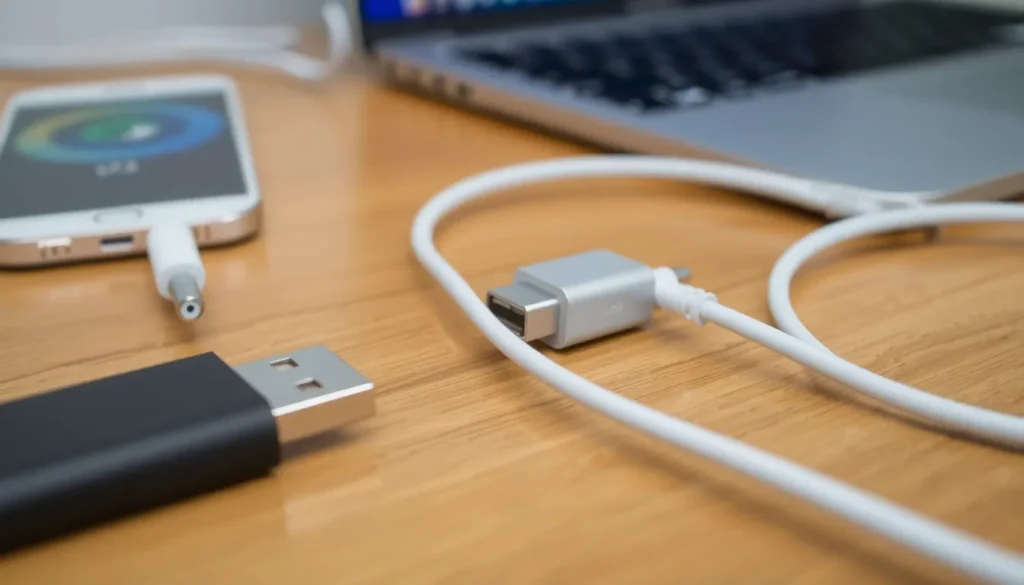Table of Contents
ToggleIn a world where every second counts and battery life feels like a ticking time bomb, charging cables are the unsung heroes of our daily lives. They’re the lifelines that keep our devices powered up and ready to tackle whatever the day throws at us. But let’s face it, not all cables are created equal. Some tangle like a cat in a yarn factory, while others seem to vanish into thin air when you need them most.
Overview Of Charging Cables
Charging cables serve a crucial function in modern technology, enabling the power supply to numerous electronic devices. Various types exist, each designed for specific uses, such as USB-C, Lightning, and Micro USB. Each type offers different characteristics, including speed and compatibility.
USB-C cables stand out for their versatility. They support fast charging and data transfer, making them suitable for a range of devices, from smartphones to laptops. Lightning cables, exclusive to Apple devices, provide efficient charging and seamless integration with iOS products. Micro USB cables remain widely used, especially for older Android devices, due to their affordability and ease of access.
Quality varies significantly among charging cables. Durable options feature reinforced connectors and robust materials, minimizing wear and tear. Conversely, low-quality cables can fray, leading to reduced performance and increased risk of damaging devices. Prioritizing purchase decisions based on brand reputation and user reviews ensures reliable performance and longevity.
Length options for charging cables also matter. Standard lengths typically range from 1 to 10 feet, catering to different needs. Shorter cables are convenient for travel, while longer ones allow for more flexibility in use.
Compatibility is another crucial factor to consider. Many devices require specific cable types to achieve optimal charging speeds. For instance, using a USB-C cable on a compatible device facilitates quick power replenishment, enhancing user experience.
Charging cables play an essential role in the daily operation of electronic devices. Understanding different types, quality aspects, and compatibility ensures effective choices in the fast-paced tech landscape.
Types Of Charging Cables

Various types of charging cables exist, each serving distinct purposes and devices. Understanding these types aids in selecting the right cable for specific needs.
USB Type-A
USB Type-A cables feature a rectangular connector, serving as a standard for computers and many chargers. These cables connect to devices like smartphones, tablets, and cameras. Users appreciate their widespread compatibility across older devices. Speeds typically reach up to 480 Mbps for data transfer. Usually, USB Type-A provides a stable power flow, supporting up to 2.5 watts of charging. This common cable type remains a reliable choice for many.
USB Type-C
USB Type-C stands out for its reversible design, making it user-friendly. Devices like laptops, smartphones, and accessories often utilize this cable due to its versatility. Capable of supporting data transfer rates up to 10 Gbps, it enables faster charging compared to older options. Noteworthy is its ability to deliver power up to 100 watts, accommodating various devices. Many manufacturers now prefer USB Type-C for its efficiency and ease of use.
Micro USB
Micro USB cables are frequently found in older smartphones and portable devices. Despite their prevalence declining due to the rise of USB Type-C, they still support many gadgets. Charging speeds typically reach 5 volts and 2 amps, making them suitable for basic power needs. Users often find them easy to replace, given their widespread availability. While less common now, Micro USB remains an essential option for specific devices.
Factors To Consider When Choosing Charging Cables
Choosing the right charging cable involves multiple factors that impact usability. Understanding these elements ensures efficient device charging.
Length
Cable length significantly affects convenience. Cables typically range from 1 to 10 feet, with longer options providing flexibility in usage. Short cables suit portable needs, while longer cables work well for home or office environments. Users often prefer longer cables for easy access to charging points. Selecting the right length also helps reduce clutter from excess cabling. Evaluating where the cable will be used aids in making the best choice.
Durability
Durability plays a critical role in cable selection. High-quality cables often feature reinforced connectors and materials that withstand wear. Cables exposed to frequent use or bending require added strength to avoid fraying. Options with braided exteriors offer additional protection against damage. Reliability increases with sturdy cables, minimizing the need for frequent replacements. Choosing durable cables protects investments in devices and enhances overall charging experiences.
Compatibility
Compatibility ensures optimal performance across devices. Different cables support varying protocols for charging and data transfer. USB Type-C cables work with most modern devices, while Micro USB primarily caters to older smartphones. Lightning cables exclusively function with Apple products, limiting their versatility. Users benefit from researching device specifications to confirm compatibility before purchasing. Ensuring compatibility helps avoid performance issues and maximizes charging efficiency.
Top Charging Cable Brands
Several charging cable brands stand out due to their reliability and performance. Consumers often prefer these brands for their quality and innovative designs.
Brand A
Anker ranks among the top charging cable brands. Anker cables support fast charging and data transfer, providing users with efficiency. They feature reinforced connectors and braided exteriors, enhancing durability significantly. A range of options exists, from USB-C to Lightning cables, catering to various devices. Customers frequently praise Anker for its excellent customer service and warranty options, making it a trusted choice for many.
Brand B
Belkin is another leading name in charging cables. Known for innovative designs, Belkin offers quality products that are compatible with a wide array of devices. Their cables allow for fast charging capabilities and maintain data transfer speeds. Belkin’s focus on durability ensures that their products last longer than average cables. Users appreciate the sleek aesthetics of Belkin products, as they blend functionality with style, appealing to tech-savvy consumers.
Charging cables are vital in today’s tech-driven world. They ensure devices remain powered and ready for use. With various types available each designed for specific needs understanding their features is essential for optimal performance.
Quality should never be overlooked as durable cables with reinforced connectors can save time and money in the long run. Choosing the right length and type based on personal requirements can enhance convenience and efficiency.
As technology continues to evolve staying informed about the latest charging cable options will help users make smarter choices. Investing in reliable brands like Anker and Belkin can lead to a better overall experience with devices.




